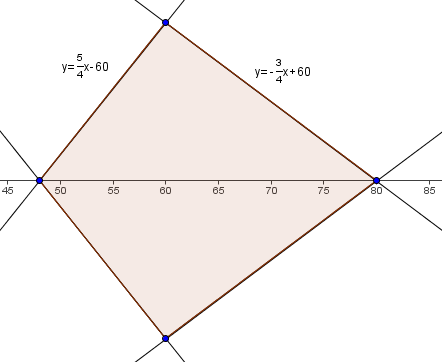- 翰林提供学术活动、国际课程、科研项目一站式留学背景提升服务!
- 400 888 0080
1987AIME 真题及答案解析
1987AIME 真题及答案解析
答案解析请参考文末
Problem 1
An ordered pair ![]() of non-negative integers is called "simple" if the addition
of non-negative integers is called "simple" if the addition ![]() in base
in base ![]() requires no carrying. Find the number of simple ordered pairs of non-negative integers that sum to
requires no carrying. Find the number of simple ordered pairs of non-negative integers that sum to ![]() .
.
Problem 2
What is the largest possible distance between two points, one on the sphere of radius 19 with center ![]() and the other on the sphere of radius 87 with center
and the other on the sphere of radius 87 with center ![]() ?
?
Problem 3
By a proper divisor of a natural number we mean a positive integral divisor other than 1 and the number itself. A natural number greater than 1 will be called "nice" if it is equal to the product of its distinct proper divisors. What is the sum of the first ten nice numbers?
Problem 4
Find the area of the region enclosed by the graph of ![]()
Problem 5
Find ![]() if
if ![]() and
and ![]() are integers such that
are integers such that ![]() .
.
Problem 6
Rectangle ![]() is divided into four parts of equal area by five segments as shown in the figure, where
is divided into four parts of equal area by five segments as shown in the figure, where ![]() , and
, and ![]() is parallel to
is parallel to ![]() . Find the length of
. Find the length of ![]() (in cm) if
(in cm) if ![]() cm and
cm and ![]() cm.
cm.

Problem 7
Let ![]() denote the least common multiple of positive integers
denote the least common multiple of positive integers ![]() and
and ![]() . Find the number of ordered triples
. Find the number of ordered triples ![]() of positive integers for which
of positive integers for which ![]() ,
, ![]() , and
, and ![]() .
.
Problem 8
What is the largest positive integer ![]() for which there is a unique integer
for which there is a unique integer ![]() such that
such that ![]() ?
?
Problem 9
Triangle ![]() has right angle at
has right angle at ![]() , and contains a point
, and contains a point ![]() for which
for which ![]() ,
, ![]() , and
, and ![]() . Find
. Find ![]() .
.

Problem 10
Al walks down to the bottom of an escalator that is moving up and he counts 150 steps. His friend, Bob, walks up to the top of the escalator and counts 75 steps. If Al's speed of walking (in steps per unit time) is three times Bob's walking speed, how many steps are visible on the escalator at a given time? (Assume that this value is constant.)
Problem 11
Find the largest possible value of ![]() for which
for which ![]() is expressible as the sum of
is expressible as the sum of ![]() consecutive positive integers.
consecutive positive integers.
Problem 12
Let ![]() be the smallest integer whose cube root is of the form
be the smallest integer whose cube root is of the form ![]() , where
, where ![]() is a positive integer and
is a positive integer and ![]() is a positive real number less than
is a positive real number less than ![]() . Find
. Find ![]() .
.
Problem 13
A given sequence ![]() of distinct real numbers can be put in ascending order by means of one or more "bubble passes". A bubble pass through a given sequence consists of comparing the second term with the first term, and exchanging them if and only if the second term is smaller, then comparing the third term with the second term and exchanging them if and only if the third term is smaller, and so on in order, through comparing the last term,
of distinct real numbers can be put in ascending order by means of one or more "bubble passes". A bubble pass through a given sequence consists of comparing the second term with the first term, and exchanging them if and only if the second term is smaller, then comparing the third term with the second term and exchanging them if and only if the third term is smaller, and so on in order, through comparing the last term, ![]() , with its current predecessor and exchanging them if and only if the last term is smaller.
, with its current predecessor and exchanging them if and only if the last term is smaller.
The example below shows how the sequence 1, 9, 8, 7 is transformed into the sequence 1, 8, 7, 9 by one bubble pass. The numbers compared at each step are underlined.
Problem 14
Compute
Problem 15
Squares ![]() and
and ![]() are inscribed in right triangle
are inscribed in right triangle ![]() , as shown in the figures below. Find
, as shown in the figures below. Find ![]() if area
if area ![]() and area
and area ![]() .
.

- Since no carrying over is allowed, the range of possible values of any digit of
 is from
is from  to the respective digit in
to the respective digit in  (the values of
(the values of  are then fixed). Thus, the number of ordered pairs will be
are then fixed). Thus, the number of ordered pairs will be  .
.
If you do not understand the above solution, consider this. For every positive integer , there is only one whole number
, there is only one whole number  that you can add to it to obtain the required sum. Also, the total number of non-negative integers that are smaller than or equal to an integer
that you can add to it to obtain the required sum. Also, the total number of non-negative integers that are smaller than or equal to an integer  is
is  because there are
because there are  positive integers that are less than it, in addition to
positive integers that are less than it, in addition to  and itself.
and itself. - The distance between the two centers of the spheres can be determined via the distance formula in three dimensions:
 . The largest possible distance would be the sum of the two radii and the distance between the two centers, making it
. The largest possible distance would be the sum of the two radii and the distance between the two centers, making it  .
. - Let
 denote the product of the distinct proper divisors of
denote the product of the distinct proper divisors of  . A number
. A number  is nice in one of two instances:
is nice in one of two instances:
- It has exactly two distinct prime divisors.
- If we let
 , where
, where  are the prime factors, then its proper divisors are
are the prime factors, then its proper divisors are  and
and  , and
, and  .
.
- If we let
- It is the cube of a prime number.
- If we let
 with
with  prime, then its proper divisors are
prime, then its proper divisors are  and
and  , and
, and  .
.
- If we let
We now show that the above are the only two cases. Suppose that another nice number existed that does not fall into one of these two categories. Then we can either express it in the form
 (with
(with  prime and
prime and  ) or
) or  (with
(with  ).
).In the former case, it suffices to note that
 .
.In the latter case, then
 .
.For
 , we need
, we need 
 .
.Since
 , in the case
, in the case  does not work.
does not work.
Thus, listing out the first ten numbers to fit this form,



 . Summing these yields
. Summing these yields  .
.
Alternatively, we could note that
 is only nice when it only has two divisors, which, when multiplied, clearly yield
is only nice when it only has two divisors, which, when multiplied, clearly yield  . We know that when the prime factorization of
. We know that when the prime factorization of  , the number of factors
, the number of factors  of
of  is
is![[f(n) = (b_1 + 1)(b_2 +1)(b_3 +1) . . . (b_m +1).]](https://latex.artofproblemsolving.com/5/9/4/594842eefd041b90b748b3913d652f567078482a.png)
Since
 is nice, it may only have
is nice, it may only have  factors (
factors ( ,
,  ,
,  , and
, and  ). This means that
). This means that  . The number
. The number  can only be factored into
can only be factored into  or
or  , which means that either
, which means that either  and
and  , or
, or  . Therefore the only two cases are
. Therefore the only two cases are  , or
, or  .
. - It has exactly two distinct prime divisors.
 Since
Since  is nonnegative,
is nonnegative,  . Solving this gives us two equations:
. Solving this gives us two equations:  . Thus,
. Thus,  . The maximum and minimum y value is when
. The maximum and minimum y value is when  , which is when
, which is when  and
and  . Since the graph is symmetric about the y-axis, we just need casework upon
. Since the graph is symmetric about the y-axis, we just need casework upon  .
.  , so we break up the condition
, so we break up the condition  :
:
 . Then
. Then  .
. . Then
. Then  .
.
The area of the region enclosed by the graph is that of the quadrilateral defined by the points
 . Breaking it up into triangles and solving or using shoelace, we get
. Breaking it up into triangles and solving or using shoelace, we get  .
.- If we move the
 term to the left side, it is factorable:
term to the left side, it is factorable:![[(3x^2 + 1)(y^2 - 10) = 517 - 10]](https://latex.artofproblemsolving.com/e/1/6/e16ed5492ca750a02f850907a11c15b3315706d5.png)
 is equal to
is equal to  . Since
. Since  and
and  are integers,
are integers,  cannot equal a multiple of three.
cannot equal a multiple of three.  doesn't work either, so
doesn't work either, so  , and
, and  . This leaves
. This leaves  , so
, so  . Thus,
. Thus,  .
. - Since
 ,
,  and the areas of the trapezoids
and the areas of the trapezoids  and
and  are the same, then the heights of the trapezoids are the same. Thus both trapezoids have area
are the same, then the heights of the trapezoids are the same. Thus both trapezoids have area  . This number is also equal to one quarter the area of the entire rectangle, which is
. This number is also equal to one quarter the area of the entire rectangle, which is  , so we have
, so we have  .In addition, we see that the perimeter of the rectangle is
.In addition, we see that the perimeter of the rectangle is  , so
, so  .Solving these two equations gives
.Solving these two equations gives  .
. - It's clear that we must have
 ,
,  and
and  for some nonnegative integers
for some nonnegative integers  . Dealing first with the powers of 2: from the given conditions,
. Dealing first with the powers of 2: from the given conditions,  ,
,  . Thus we must have
. Thus we must have  and at least one of
and at least one of  equal to 3. This gives 7 possible triples
equal to 3. This gives 7 possible triples  :
:  and
and  .Now, for the powers of 5: we have
.Now, for the powers of 5: we have  . Thus, at least two of
. Thus, at least two of  must be equal to 3, and the other can take any value between 0 and 3. This gives us a total of 10 possible triples:
must be equal to 3, and the other can take any value between 0 and 3. This gives us a total of 10 possible triples:  and three possibilities of each of the forms
and three possibilities of each of the forms  ,
,  and
and  .Since the exponents of 2 and 5 must satisfy these conditions independently, we have a total of
.Since the exponents of 2 and 5 must satisfy these conditions independently, we have a total of  possible valid triples.
possible valid triples. and
and  . By looking at the prime factorization of
. By looking at the prime factorization of  ,
,  must have a factor of
must have a factor of  . If
. If  has a factor of
has a factor of  , then there are two cases: either (1)
, then there are two cases: either (1)  or
or  , or (2) one of
, or (2) one of  and
and  has a factor of
has a factor of  and the other a factor of
and the other a factor of  . For case 1, the other number will be in the form of
. For case 1, the other number will be in the form of  , so there are
, so there are  possible such numbers; since this can be either
possible such numbers; since this can be either  or
or  there are a total of
there are a total of  possibilities. For case 2,
possibilities. For case 2,  and
and  are in the form of
are in the form of  and
and  , with
, with  and
and  (if they were equal to 3, it would overlap with case 1). Thus, there are
(if they were equal to 3, it would overlap with case 1). Thus, there are  cases.If
cases.If  does not have a factor of
does not have a factor of  , then at least one of
, then at least one of  and
and  must be
must be  , and both must have a factor of
, and both must have a factor of  . Then, there are
. Then, there are  solutions possible just considering
solutions possible just considering  , and a total of
, and a total of  possibilities. Multiplying by three, as
possibilities. Multiplying by three, as  , there are
, there are  . Together, that makes
. Together, that makes  solutions for
solutions for  .
. - Multiplying out all of the denominators, we get:
 Since
Since  ,
,  . Also,
. Also,  , so
, so  . Thus,
. Thus,  .
.  is unique if it is within a maximum range of
is unique if it is within a maximum range of  , so
, so  .Flip all of the fractions for
.Flip all of the fractions for![[begin{array}{ccccc}frac{15}{8} &>& frac{k + n}{n} &>& frac{13}{7}\ 105n &>& 56 (k + n)& >& 104n\ 49n &>& 56k& >& 48nend{array}]](https://latex.artofproblemsolving.com/b/e/f/bef75a0b9482dd0efc4ff0cb17d912353663dc8f.png)
Continue as in Solution 1.
Flip the fractions and subtract one from all sides to yield
![[frac{7}{8}>frac{k}{n}>frac{6}{7}.]](https://latex.artofproblemsolving.com/f/4/1/f41b60503cc047170384ab0c8c6beaa2b5d445bc.png) Multiply both sides by
Multiply both sides by  to get
to get![[49n>56k>48n.]](https://latex.artofproblemsolving.com/e/6/d/e6d8522ade54297b4b99cdf736df90358fcb5bac.png) This is equivalent to find the largest value of
This is equivalent to find the largest value of  such that there is only one multiple of 56 within the open interval between
such that there is only one multiple of 56 within the open interval between  and
and  . If
. If  then
then  and
and  is the unique value. For
is the unique value. For  there is at least
there is at least  possible numbers for
possible numbers for  and there is one
and there is one  every 56 numbers. Hence, there must be at least two values of
every 56 numbers. Hence, there must be at least two values of  that work. So, the largest value of
that work. So, the largest value of  is
is  .
. - Let
 . Since
. Since  , each of them is equal to
, each of them is equal to  . By the Law of Cosines applied to triangles
. By the Law of Cosines applied to triangles  ,
,  and
and  at their respective angles
at their respective angles  , remembering that
, remembering that  , we have
, we have![[AB^2 = 36 + 100 + 60 = 196, BC^2 = 36 + x^2 + 6x, CA^2 = 100 + x^2 + 10x]](https://latex.artofproblemsolving.com/3/8/1/3811f0cadac72e5493473cc57a2249d160ce488c.png) Then by the Pythagorean Theorem,
Then by the Pythagorean Theorem,  , so
, so![[x^2 + 10x + 100 = x^2 + 6x + 36 + 196]](https://latex.artofproblemsolving.com/6/8/8/688be5159b368f96110b866f2f826348c7f9c0d2.png) and
and
![[4x = 132 Longrightarrow x = boxed{033}.]](https://latex.artofproblemsolving.com/b/9/6/b96d8f130f6036d0500a38ca00ce1281338256c8.png)
- Let the total number of steps be
 , the speed of the escalator be
, the speed of the escalator be  and the speed of Bob be
and the speed of Bob be  .In the time it took Bob to climb up the escalator he saw 75 steps and also climbed the entire escalator. Thus the contribution of the escalator must have been an additional
.In the time it took Bob to climb up the escalator he saw 75 steps and also climbed the entire escalator. Thus the contribution of the escalator must have been an additional  steps. Since Bob and the escalator were both moving at a constant speed over the time it took Bob to climb, the ratio of their distances covered is the same as the ratio of their speeds, so
steps. Since Bob and the escalator were both moving at a constant speed over the time it took Bob to climb, the ratio of their distances covered is the same as the ratio of their speeds, so  .Similarly, in the time it took Al to walk down the escalator he saw 150 steps, so the escalator must have moved
.Similarly, in the time it took Al to walk down the escalator he saw 150 steps, so the escalator must have moved  steps in that time. Thus
steps in that time. Thus  or
or  .Equating the two values of
.Equating the two values of  we have
we have  and so
and so  and
and  and
and  , the answer.Again, let the total number of steps be
, the answer.Again, let the total number of steps be  , the speed of the escalator be
, the speed of the escalator be  and the speed of Bob be
and the speed of Bob be  (all "per unit time").
(all "per unit time").
Then this can be interpreted as a classic chasing problem: Bob is "behind" by
 steps, and since he moves at a pace of
steps, and since he moves at a pace of  relative to the escalator, it will take
relative to the escalator, it will take  time to get to the top.
time to get to the top.Similarly, Al will take
 time to get to the bottom.
time to get to the bottom.From these two equations, we arrive at

 , where we have used the fact that
, where we have used the fact that  (the proportion manipulations are motivated by the desire to isolate
(the proportion manipulations are motivated by the desire to isolate  , prompting the isolation of the
, prompting the isolation of the  on one side, and the fact that if we could cancel out the
on one side, and the fact that if we could cancel out the  's, then the
's, then the  's in the numerator and denominator would cancel out, resulting in an equation with
's in the numerator and denominator would cancel out, resulting in an equation with  by itself).
by itself).Let
 ,
,  be the speeds of the escalator and Bob, respectively.
be the speeds of the escalator and Bob, respectively.When Al was on his way down, he took
 steps with a speed of
steps with a speed of  per step. When Bob was on his way up, he took
per step. When Bob was on his way up, he took  steps with a speed of
steps with a speed of  per step. Since Al and Bob were walking the same distance, we have
per step. Since Al and Bob were walking the same distance, we have![[150(3b-e)=75(b+e)]](https://latex.artofproblemsolving.com/3/1/2/312f9746ca9df6dc2b9f7557b468afbddbd1dbdf.png) Solving gets the ratio
Solving gets the ratio  .
.Thus while Bob took
 steps to go up, the escalator has contributed an extra
steps to go up, the escalator has contributed an extra  steps.
steps.Finally, there is a total of
 steps in the length of the escalator.
steps in the length of the escalator. - Let us write down one such sum, with
 terms and first term
terms and first term  :
: .Thus
.Thus  so
so  is a divisor of
is a divisor of  . However, because
. However, because  we have
we have  so
so  . Thus, we are looking for large factors of
. Thus, we are looking for large factors of  which are less than
which are less than  . The largest such factor is clearly
. The largest such factor is clearly  ; for this value of
; for this value of  we do indeed have the valid expression
we do indeed have the valid expression  , for which
, for which  .
. - In order to keep
 as small as possible, we need to make
as small as possible, we need to make  as small as possible.
as small as possible. . Since
. Since  and
and  is an integer, we must have that
is an integer, we must have that  . This means that the smallest possible
. This means that the smallest possible  should be quite a bit smaller than 1000. In particular,
should be quite a bit smaller than 1000. In particular,  should be less than 1, so
should be less than 1, so  and
and  .
.  , so we must have
, so we must have  . Since we want to minimize
. Since we want to minimize  , we take
, we take  . Then for any positive value of
. Then for any positive value of  ,
,  , so it is possible for
, so it is possible for  to be less than
to be less than  . However, we still have to make sure a sufficiently small
. However, we still have to make sure a sufficiently small  exists.In light of the equation
exists.In light of the equation  , we need to choose
, we need to choose  as small as possible to ensure a small enough
as small as possible to ensure a small enough  . The smallest possible value for
. The smallest possible value for  is 1, when
is 1, when  . Then for this value of
. Then for this value of  ,
,  , and we're set. The answer is
, and we're set. The answer is  .
. - If any of
 is larger than
is larger than  , one of these numbers will be compared with
, one of these numbers will be compared with  on the 19th step of the first bubble pass and
on the 19th step of the first bubble pass and  will be moved back to the 19th position. Thus,
will be moved back to the 19th position. Thus,  must be the largest of the first 20 terms. In addition,
must be the largest of the first 20 terms. In addition,  must be larger than
must be larger than  but smaller than
but smaller than  in order that it move right to the 30th position but then not continue moving right to the 31st.Thus, our problem can be restated: What is the probability that in a sequence of 31 distinct real numbers, the largest is in position 31 and the second-largest is in position 20 (the other 29 numbers are irrelevant)?This is much easier to solve: there are
in order that it move right to the 30th position but then not continue moving right to the 31st.Thus, our problem can be restated: What is the probability that in a sequence of 31 distinct real numbers, the largest is in position 31 and the second-largest is in position 20 (the other 29 numbers are irrelevant)?This is much easier to solve: there are  ways to order the first thirty-one numbers and
ways to order the first thirty-one numbers and  ways to arrange them so that the largest number is in the 31st position and the second-largest is in the 20th. This gives us a desired probability of
ways to arrange them so that the largest number is in the 31st position and the second-largest is in the 20th. This gives us a desired probability of  , so the answer is
, so the answer is  .
. - The Sophie Germain Identity states that
 can be factorized as
can be factorized as  . Each of the terms is in the form of
. Each of the terms is in the form of  . Using Sophie-Germain, we get that
. Using Sophie-Germain, we get that  .
.
![$frac{[(10(10-6)+18)(10(10+6)+18)][(22(22-6)+18)(22(22+6)+18)]cdots[(58(58-6)+18)(58(58+6)+18)]}{[(4(4-6)+18)(4(4+6)+18)][(16(16-6)+18)(16(16+6)+18)]cdots[(52(52-6)+18)(52(52+6)+18)]}$](https://latex.artofproblemsolving.com/4/d/f/4df1c85169d79080a1e4ad7cd3cb96f9c11ec0c7.png)

Almost all of the terms cancel out! We are left with
 .
.  Because all the triangles in the figure are similar to triangle
Because all the triangles in the figure are similar to triangle  , it's a good idea to use area ratios. In the diagram above,
, it's a good idea to use area ratios. In the diagram above,  Hence,
Hence,  and
and  . Additionally, the area of triangle
. Additionally, the area of triangle  is equal to both
is equal to both  and
and  Setting the equations equal and solving for
Setting the equations equal and solving for  ,
,  . Therefore,
. Therefore,  . However,
. However,  is equal to the area of triangle
is equal to the area of triangle  ! This means that the ratio between the areas
! This means that the ratio between the areas  and
and  is
is  , and the ratio between the sides is
, and the ratio between the sides is  . As a result,
. As a result,  . We now need
. We now need  to find the value of
to find the value of  , because
, because  .Let
.Let  denote the height to the hypotenuse of triangle
denote the height to the hypotenuse of triangle  . Notice that
. Notice that  . (The height of
. (The height of  decreased by the corresponding height of
decreased by the corresponding height of  ) Thus,
) Thus,  . Because
. Because  ,
,  .Let
.Let  . Now using the 1st square,
. Now using the 1st square,  and
and  . Using the second square,
. Using the second square,  . We have
. We have  , or
, or![[441(x^2+x^{-2}+2x+2x^{-1}+2)=440(x^2+x^{-2}+2x+2x^{-1}+3).]](https://latex.artofproblemsolving.com/5/d/f/5dfaa54500d33df79590938c9216add0bdaf8e9c.png) Rearranging and letting
Rearranging and letting  gives us
gives us  We take the positive root, so
We take the positive root, so  , which means
, which means  .
.
学术活动报名扫码了解!免费领取历年真题!

最新发布
© 2025. All Rights Reserved. 沪ICP备2023009024号-1









